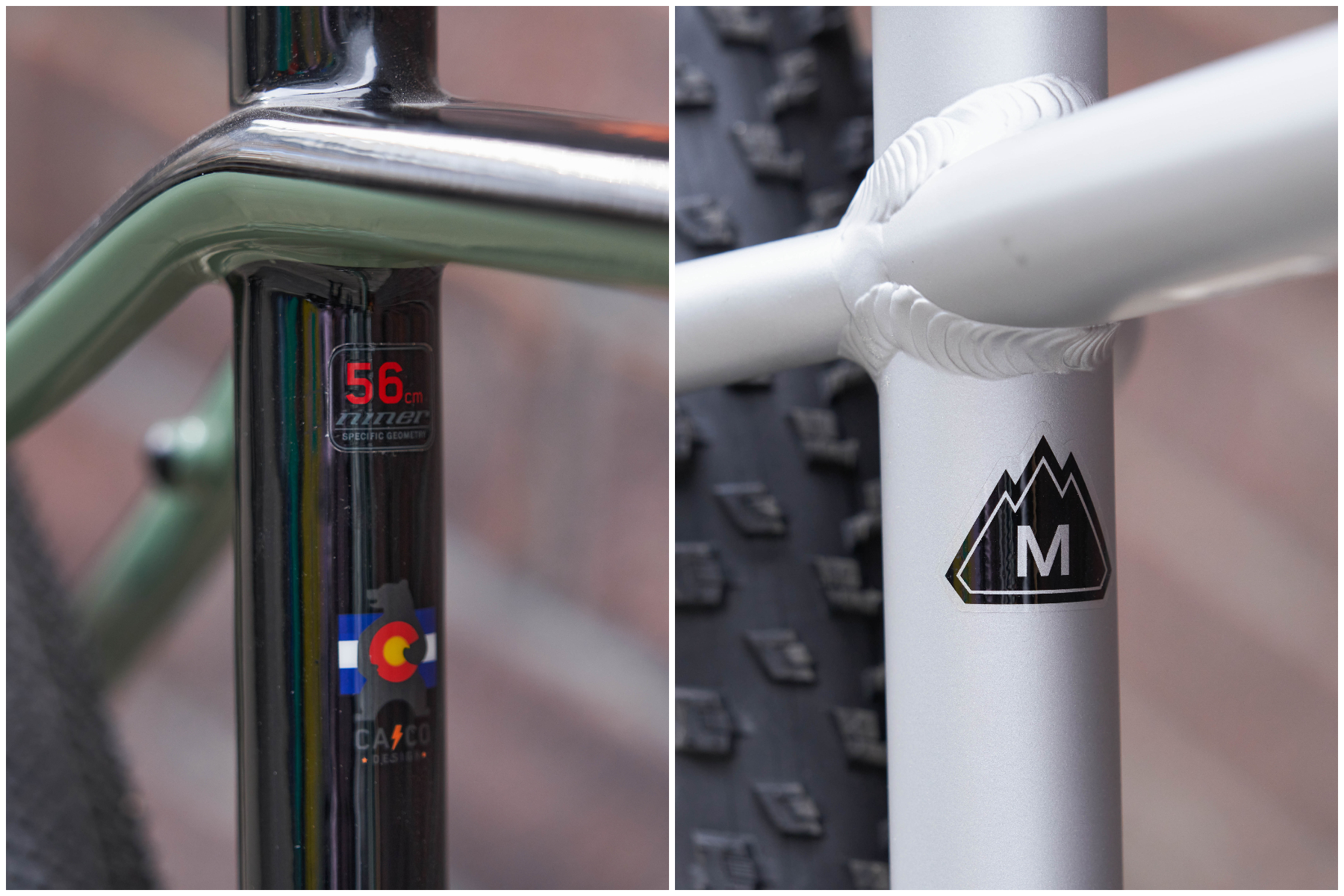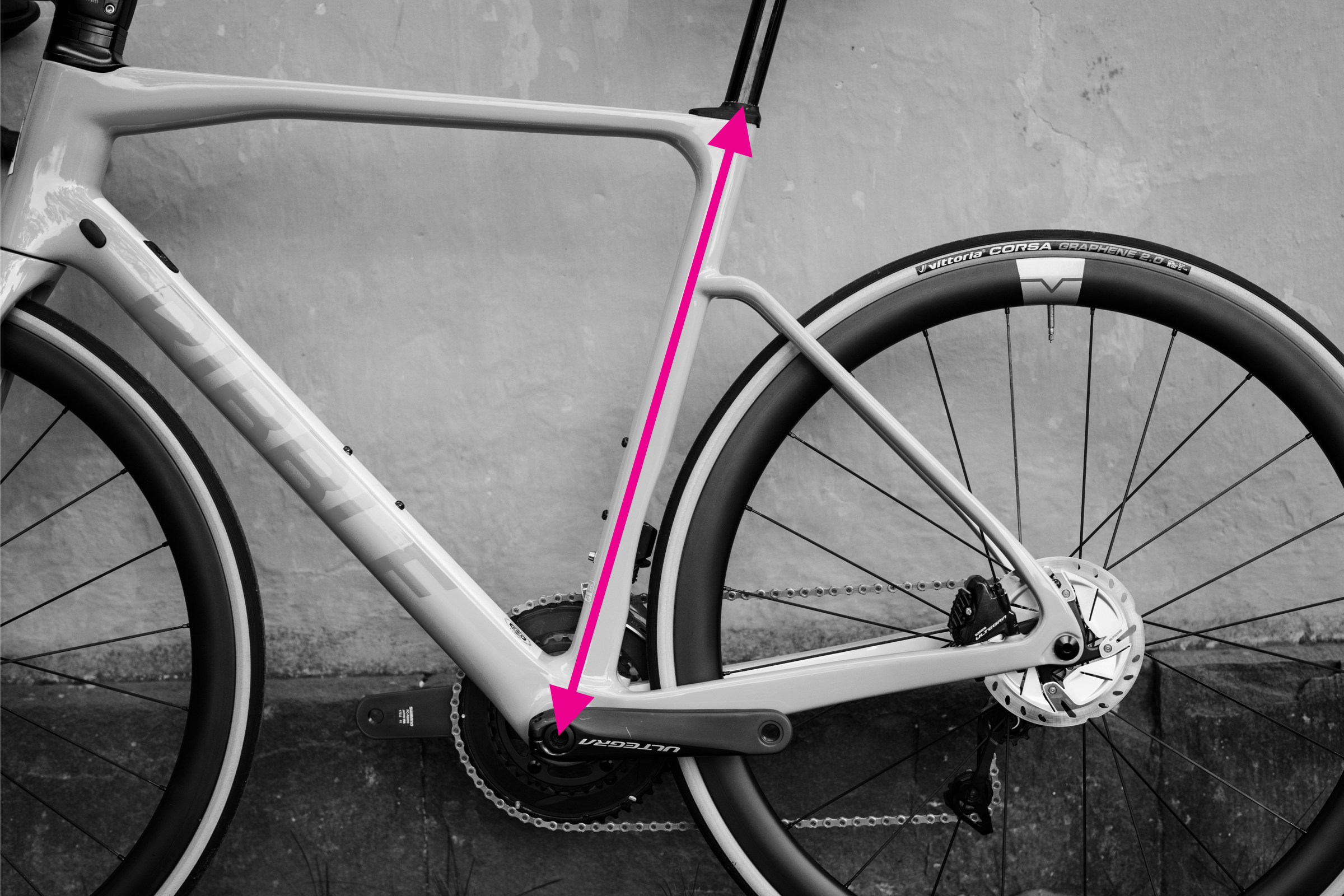BikeRadar’s beginner’s guide to finding the right size bike
Establishing the correct bike size for you is one of the most important things to do when buying a new bicycle.
Although there’s a lot you can adjust on a bike so that it fits better, if you start off with a frame that’s too small or too large for you, you may be placed awkwardly and uncomfortable as you ride.
That can result in aches and pains when cycling and your bike not handling as it should, both of which can limit your enjoyment when out riding.
With that in mind, here’s everything you need to know about bike sizes – be it a mountain bike, road bike, hybrid bike, women’s-specific bike or child’s bike.
Bike size chart
We’ll cover the nuances of road bike, mountain bike, hybrid bike and gravel bike sizes shortly, but here’s an overview of typical frame sizes, according to rider height.
However, body dimensions and frame layouts can vary significantly from one person and brand to the next, so seek further advice, specific to the bike you are intending to buy, before purchasing.
| Rider height (cm) | Rider height (feet) | Road bike frame size (cm) | MTB frame size (inches) |
|---|---|---|---|
| 143–155cm | 4ft 8in – 5ft 1in | 44cm | 13in |
| 155–163cm | 5ft 1in – 5ft 4in | 48cm | 15in |
| 163–170cm | 5ft 4in – 5ft 7in | 51cm | 16in |
| 170–178cm | 5ft 7in – 5ft 10in | 54cm | 18in |
| 178–183cm | 5ft 10in – 6ft | 56cm | 19in |
| 183–191cm | 6ft – 6ft 3in | 58cm | 20in |
| 191–196cm | 6ft 3in – 6ft 5in | 60cm | 21in |
| 196–205cm | 6ft 5in – 6ft 49in | 62cm | 22in |
How do I know what size bike I need?
There are a number of ways to find your correct bike size.
1) Rider height and inside leg
The quickest method is often to look on a brand’s site.
Usually, there will be a chart with recommended bike sizes for different rider heights, so it’s comparatively easy to see where you fit.
Some brands will have an interactive size guide, where you input your height and often other details, such as inside leg length, to find your recommended size.
However, don't take a brand's size guide as gospel – it's a guide, after all, and one person's dimensions and requirements can vary from another, even if they are the same height.
Equally, if you are between sizes, you will need to decide whether to size up or size down. More on that to come.
2) Go to your local bike shop
Next up, if you’re buying a bike from a physical shop, you can ask them what size you need. Sometimes, you’ll just get eyeballed and the assistant will put you on a bike to see if you fit.
However, bike shops are getting more sophisticated, so you might get a proper sizing, where the shop staff will measure you and determine more precisely what size bike you need.
Find a good local bike shop that takes the time to ensure you’re buying the right size bike.
3) Bike fit
Finally, some shops will offer you a discounted or free bike fit as part of your purchase. This is the most sophisticated option, not only to make sure you get a frame that fits, but to have your contact points set correctly so you'll be comfortable and efficient when riding.
You may be advised to swap out components such as the stock saddle for something that better suits your sit bone anatomy or to opt for a non-standard bar width or stem length, for example.
A bike fit will also help you to determine key setup measurements, such as saddle height, which are crucial to finding a comfortable and efficient riding position. We’ll cover this in more detail later.
What if I'm between sizes?
There’s normally an overlap between frame sizes, so you’ll often have a choice of two sizes.
If you sit between two frame sizes, the common advice is to take the smaller of the two options. There’s a lot you can adjust easily on bikes, such as saddle height, saddle setback and handlebar height, to fine-tune the fit.
However, seek further advice from the bike brand or your local shop, if you're unsure.
Road bike size guide

The most common way of sizing road bikes is by seat tube length in centimetres.
However, this will be different depending on whether the frame has a sloping or a horizontal top tube, so you’ll often see 'effective' seat tube lengths quoted, based on a horizontal line between the head tube and the seatpost.
Some brands just give you S, M, L (and often XS and XL) sizes. Others, such as Colnago and Pinarello, have their own unique sizing systems.
That means you’ll need to revert to the brand’s size info, as described above, or study the road bike’s geometry chart to work out which bike size is best for you.
See our guide to road bike sizing for more detailed information.
| Rider height | Frame size | ||
|---|---|---|---|
| Feet and inches | Centimetres | Effective top tube (cm) | Bike size |
| 4ft 10in – 5ft | 148-152 | 47-48 | XXS |
| 5ft – 5ft 3in | 152-160 | 49-50 | XS |
| 5ft 3in – 5ft 6in | 160-168 | 51- 3 | S |
| 5ft 6in – 5ft 9in | 168-175 | 54-55 | M |
| 5ft 9in – 6ft | 175-183 | 56-58 | L |
| 6ft – 6ft 3in | 183-191 | 58-60 | XL |
| 6ft 3in – 6ft 6in | 191-198 | 61-63 | XXL |
Mountain bike size guide

When it comes to mountain bike sizing, most brands have reverted to an S, M, L (etc) sizing method for their frames.
With mountain bike seat tube lengths being highly dependent on the frame geometry and rear-suspension layout, T-shirt-style sizing provides the clearest guide.
The trend for long and slack mountain bike geometry has accentuated the difficulty in selecting a frame size based on seat tube length alone and some brands now rely on reach (the horizontal distance from the centre of the bottom bracket to the top of the head tube) to define their frame sizes.
Seat tube length is still an important consideration though, because you need to be able to get your saddle height right. If you want to fit a dropper post, a short seat tube may also mean some models won't fit.
Finally, MTB frame sizes are significantly smaller than for road bikes, so don’t try to compare your road bike and mountain bike sizing.
We’ve got a lot more info in our mountain bike sizing guide.
| Bike size | Frame size | Rider height |
|---|---|---|
| Extra-small | 13-14in | 152-162cm (5ft – 5ft 4in) |
| Small | 14-16in | 162-170cm (5ft 4in – 5ft 7in) |
| Medium | 16-18in | 170-178cm (5ft 7in – 5ft 10in) |
| Large | 18-20in | 178-185cm (5ft 10in – 6ft 1in) |
| Extra-large | 20-22in | 185cm plus (6ft 1in plus) |
Mountain bike sizing, geometry and riding style
It’s a good idea to study our guide to mountain bike geometry to understand the key measurements of an MTB frame, and how they affect a bike’s handling characteristics and fit.
The type of riding your bike is designed for alters its geometry, too. If you’re riding a cross-country bike, designed for agile handling, you may want to be more stretched out, while beginners may prefer a shorter reach so that they’re more upright, with less strain placed on the hands and wrists.
Bikes designed for more aggressive riding, including the latest downcountry bikes, trail bikes and enduro bikes, will typically have a longer, slacker geometry to match, which may have a knock-on impact on finding the correct frame size.
With the trend for bikes to have slacker head tube angles, it’s important to get your position forward enough to weight the front wheel and the suspension effectively, so you don’t want a frame and seat position that sits you too far back. Again, a geometry chart is the best way to work out the best frame size for a comfortable fit.
Gravel bike size guide

Gravel bike sizing is much like road bike sizing, with most brands using the seat tube length in centimetres to size frames, though T-shirt-style sizing is, once again, also used by some brands.
In general, your position on a gravel bike will be more relaxed and upright than on a road race bike.
That’s because you need to be able to shift your weight around more off-road to balance and steer your bike over obstacles. A more upright position will also be more comfortable over uneven terrain.
Having said that, if you’re interested in gravel racing, a longer and lower position will reduce your frontal profile and potentially make you faster, and the geometry of many of the latest go-fast gravel bikes is shaped accordingly.
As when choosing a road bike, pay attention to the geometry of a gravel bike when choosing your next ride. Buying a bike that matches your riding intentions is vital.
| Rider height | Frame size | ||
|---|---|---|---|
| Feet and inches | Centimetres | Effective top tube (cm) | Bike size |
| 4ft 10in – 5ft | 148-152 | 47-48 | XXS |
| 5ft – 5ft 3in | 152-160 | 49-50 | XS |
| 5ft 3in – 5ft 6in | 160-168 | 51- 3 | S |
| 5ft 6in – 5ft 9in | 168-175 | 54-55 | M |
| 5ft 9in – 6ft | 175-183 | 56-58 | L |
| 6ft – 6ft 3in | 183-191 | 58-60 | XL |
| 6ft 3in – 6ft 6in | 191-198 | 61-63 | XXL |
Women’s bike size guide

Women's frame sizes can vary significantly depending on a brand's outlook on women's bikes.
Some brands, such as Liv, have women’s-specific geometry and women’s bike ranges designed from the ground up. As a result, the range of sizes on offer will also be specific to women.
Other brands, meanwhile, assert that there are more differences in body proportions among people of the same sex than there are between sexes, and label all their bikes as unisex as a result, following a 'unisex' size guide.
In the middle, you have brands that offer 'unisex' frames but with specification tweaks to cater for women.
Some brands – such as Canyon, on its women's-specced WMN road bikes – fit smaller 650b wheels to their smaller frame sizes, so that geometry and handling can be kept consistent through the range.
We’ve got a separate guide to women’s bike sizing to cover the topic in detail, including the difference between road, mountain and hybrid bike sizes for women.
Kids’ bike size guide
As with adult bikes, it’s vital to get the size correct for a child's bike.
Age range is often quoted by bike brands as a way to size kids’ bikes but, because children grow at different rates, it’s not the best way to make sure a bike will fit comfortably.
Measuring your child

Measuring your child is an important first step in choosing the right kids’ bike size.
That starts off with their inside leg measurement. You also need to measure their height.
For the majority of the best kids’ bikes, that should give you the info you need to hone in on the correct bike size.
Wheel sizes

As we cover in our kids’ bike size guide, children’s bikes are normally sold by wheel size (in inches), with sizes increasing from 12-inch balance bikes, via 14in, 16in, 20in, 24in and 26in.
| Approx age | Wheel size (in) | Minimum inseam (in) | Minimum inseam (cm) | Minimum height (ft, in) | Minimum height (cm) |
|---|---|---|---|---|---|
| 2+ | 12 (balance bike) | 12 | 30 | 2,8 | 88 |
| 3+ | 14 | 15 | 38 | 3,3 | 98 |
| 4+ | 16 | 16 | 42 | 3,5 | 104 |
| 5+ | 18 | 18 | 46 | 3,8 | 112 |
| 6+ | 20 | 20 | 52 | 3,11 | 120 |
| 8+ | 24 | 23 | 57 | 4,2 | 127 |
| 10+ | 26 | 25 | 64 | 4,7 | 140 |
What if a child is in between sizes?
It’s tempting to buy a size up so that they’ll grow into it in a few months. That’s not optimal, not least if you're teaching a child to ride a bike for the first time.
If they’re not able to ride the bike comfortably and put a foot down easily, they may feel nervous, lose confidence, and be put off riding. It’s also easier for a child to overbalance and have a fall if the bike is too large for them.
Some brands have trade-up schemes with a discount on a larger bike when they’ve grown out of their current one.
How are bike sizes measured?

Bike sizes are measured in a number of different ways and, confusingly, there’s little consistency between bike types or between brands.
Road bike sizes are typically measured in centimetres, based on the length of the seat tube (from the bottom bracket to the top tube), although as we’ll see the actual seat tube length will vary dependent on the frame geometry.

On the other hand, mountain bike frame sizes are typically measured in inches, because they originated in the US.
You can’t compare mountain bike frame sizes directly to road bike frame sizes – not just because they’re in different units of measurement, but also because the frames on mountain bikes usually have much shorter seat tubes than those found on road bikes.
To get around the difficulty of measuring frame sizes, some brands use T-shirt sizing (e.g. S, M, L) for all their bikes, based principally on rider height.
But again, this measure isn’t consistent between brands. Indeed, brands that sell both road and mountain bikes may use a different sizing convention between the two.
Children’s bikes use different sizes again, often based either on a child’s age or the bike’s wheel size.
How to find your bike's size
If you have a current bike, you can look at the frame size sticker on it to find what size it is. This will often be located on the seat tube, but might be in a more discreet location, such as under the bottom-bracket area.
If it’s a recently sold model, you should be able to find a geometry chart for your frame on your bike brand’s website.
Alternatively, you can measure your frame size yourself, as we explain in this piece on how to measure a bike frame.